 It has been a real treat to observe the apiary at Two Fish Farms, which now includes seven colonies. The two latest additions are a Langstroth hive and a horizontal top bar hive (HTBH) with an observation window, installed from a nuclear HTBH. I have spent many hours observing the flowering plants on the property to see what the bees are foraging on in this dry, northwestern Michigan summer.
It has been a real treat to observe the apiary at Two Fish Farms, which now includes seven colonies. The two latest additions are a Langstroth hive and a horizontal top bar hive (HTBH) with an observation window, installed from a nuclear HTBH. I have spent many hours observing the flowering plants on the property to see what the bees are foraging on in this dry, northwestern Michigan summer.
The package bees are “small cell” bees, from colonies that make their own honeycomb, so they are smaller sized than the Langstroth hive bees which are born from comb built on manufactured comb foundation. This makes it possible to identify whether a foraging bee is from the Langstroth hive or a top bar hive.
A few more comments on setting up a new hive and installation of nucs and packages in HTBHs. I wasn’t able to get photos of the installation of the HTBH nuc, as I was working alone. It went very smoothly, and the bees were very gentle. The nuc was a five bar hive with an entrance along the long side, perpendicular to the comb. The empty nuc hive is now set on a post about 6 1/2 feet high in the apiary, to serve as a swarm trap, should any of the colonies decide to swarm.
When new hives are placed, hives should be at least relatively level from front to back, to ensure that comb can hang straight from the top bars. Shims can be used to level hives, as needed.
For the last weeks of supplemental feeding of the hives, I upgraded to an easy to make feeder — quart canning jars raised above the bottom board on scrap wood. Punching some small holes in the lids (I used a staple gun to punch the holes) allows bees to feed on the sugar solution. The jars worked very well and are easy to monitor.
 Supplemental feeding for new hives can be discontinued when the first strong nectar flow starts. In this case, the flow came from blackberry and raspberry (Rubus spp.) which is abundant at wood edges and on logged slopes.
Supplemental feeding for new hives can be discontinued when the first strong nectar flow starts. In this case, the flow came from blackberry and raspberry (Rubus spp.) which is abundant at wood edges and on logged slopes.
It is very helpful when a colony is creating new honeycomb in a top bar hive to ensure that the comb is formed in the centers of the top bars and runs the length of the top bar, without bending or slanting. “Cross combing” is when a single honeycomb runs across multiple top bars. This makes removing a bar of comb difficult to do without damaging it, and makes hive management more challenging.
It is fairly easy to remove small pieces of comb that are poorly positioned and reattach them to the top bar so they are aligned properly. To reattach comb, remove it with a hive tool and firmly but gently mash part of the top of the comb onto the center of the top bar in the desired position. Bees will strengthen the attachment as they expand the reattached comb.
When adding new top bars to a colony that is expanding, a combless bar can be put between between two bars with straight combs, to help ensure new comb is formed properly.
About half the new top bar hives create nice, straight comb, and half had problematic areas that needed correcting.
 Peak nectar flow has hit, with the spotted knapweed (Centaurea stoebe, syn. C. maculosa) starting to bloom strongly in mid July.
Peak nectar flow has hit, with the spotted knapweed (Centaurea stoebe, syn. C. maculosa) starting to bloom strongly in mid July.
This introduced, invasive species is only loved by beekeepers, as it is an excellent honey plant. Knapweed honey is often marketed under the name star thistle honey, and is estimated to generate $40 million to Michigan’s economy annually. Last season, extended drought reduced or eliminated its nectar flow. so far this season, the bees are working it strongly.
Other strongly attractive plants for honeybee forage this season include:
 Nepeta (Nepeta racemosa) is a long-blooming, clump-forming hardy perennial with fragrant foliage. Plants were consistently attractive to bees and have good drought tolerance.
Nepeta (Nepeta racemosa) is a long-blooming, clump-forming hardy perennial with fragrant foliage. Plants were consistently attractive to bees and have good drought tolerance.
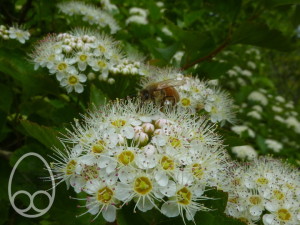 Ninebark (Physocarpus opulifolius) – this shrub produces clusters of white flowers which very attractive to bees. Plants bloom for only about a week, and then produce ornamental seedheads.
Ninebark (Physocarpus opulifolius) – this shrub produces clusters of white flowers which very attractive to bees. Plants bloom for only about a week, and then produce ornamental seedheads.
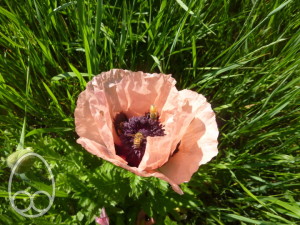 Oriental poppy (Papaver orientale) – honey bees were very strongly drawn to the first oriental poppies to flower, but did not persist on the plants for more than a few days. They almost seemed drunk on the pollen when they were actively foraging.
Oriental poppy (Papaver orientale) – honey bees were very strongly drawn to the first oriental poppies to flower, but did not persist on the plants for more than a few days. They almost seemed drunk on the pollen when they were actively foraging.
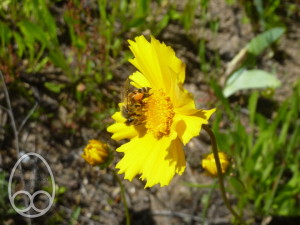 Sand coreopsis (Coreopsis lanceolata) – is a native species that proved strongly attractive to bees as well as hover flies (syrphids). Plants are drought tolerant, with yellow flowers in a range of sizes and petal widths.
Sand coreopsis (Coreopsis lanceolata) – is a native species that proved strongly attractive to bees as well as hover flies (syrphids). Plants are drought tolerant, with yellow flowers in a range of sizes and petal widths.
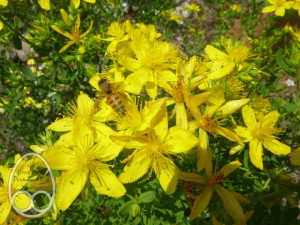 St. John’s wort (Hypericum perfoliatum) – this European native was visited by honey bees, but did not consistently attract them. Bumblebees were consistently prevalent.
St. John’s wort (Hypericum perfoliatum) – this European native was visited by honey bees, but did not consistently attract them. Bumblebees were consistently prevalent.
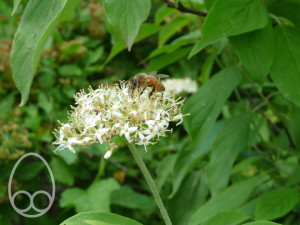 Silky dogwood (Cornus amomum) also proved attractive to bees (and rose chafers, Macrodactylus subspinosus). This native shrub produces blue berries attractive to wild birds.
Silky dogwood (Cornus amomum) also proved attractive to bees (and rose chafers, Macrodactylus subspinosus). This native shrub produces blue berries attractive to wild birds.
